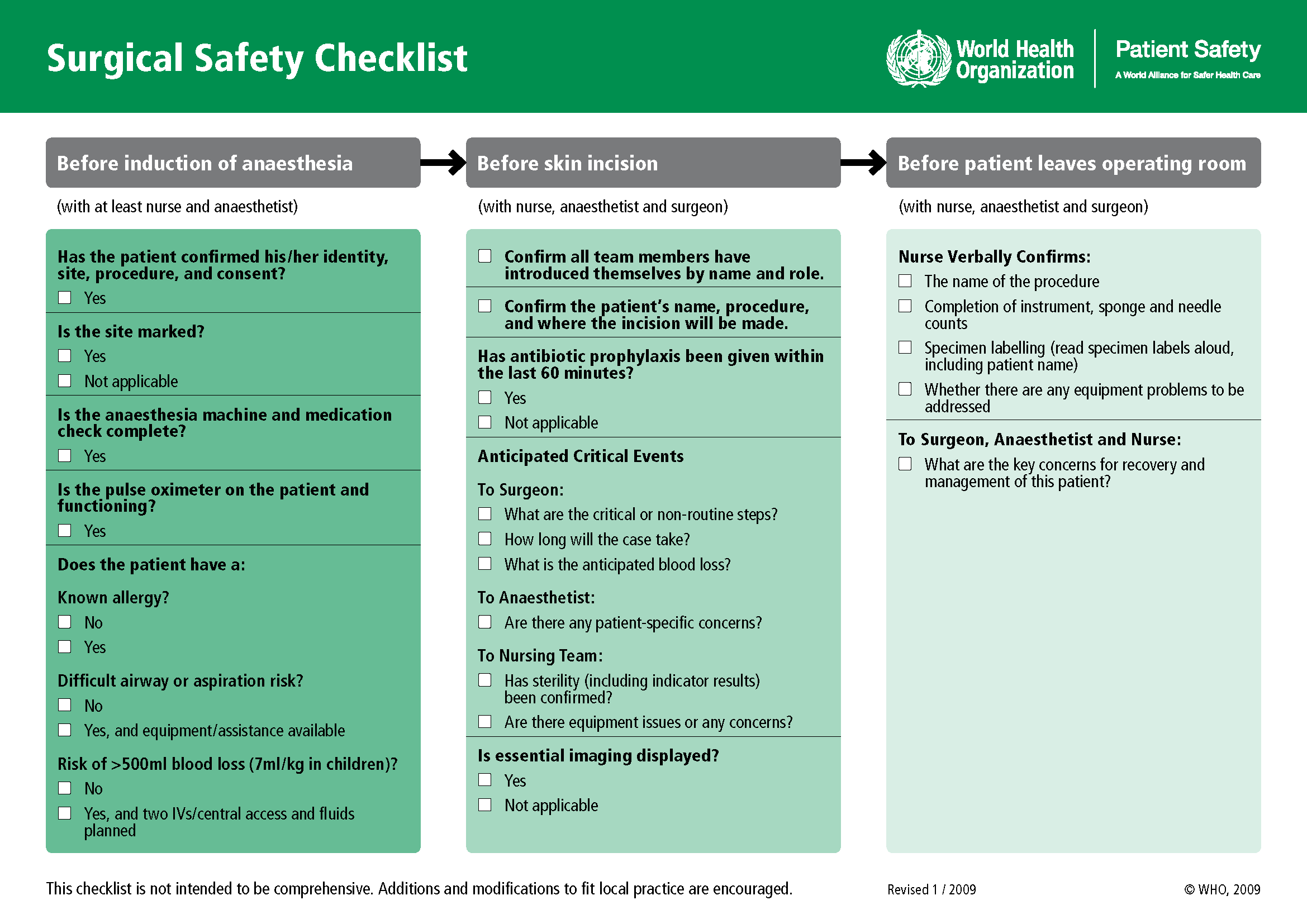5.3 Safety Strategies
Safety strategies have been developed based on research to reduce the likelihood of errors and to create safe standards of care. Examples of safety initiatives include strategies to prevent medication errors, standardized checklists, and structured team communication tools.
Medication Errors
Several initiatives have been developed nationally to prevent medication errors, such as the establishment of a “Do Not Use List of Abbreviations,” a “List of Error-Prone Abbreviations,” “Frequently Confused Medication List,” “High-Alert Medications List,” and the “Do Not Crush List.” Additionally, it is considered a standard of care for nurses to perform three checks of the rights of medication administration whenever administering medication. View more information about these safety initiatives to prevent medication errors using the hyperlinks provided below. Specific strategies to prevent medication errors are discussed in the “Preventing Medication Errors” of the “Legal/Ethical” chapter of the Open RN Nursing Pharmacology textbook. The rights of medication administration are discussed in the “Basic Concepts of Administering Medications” section of the “Administration of Enteral Medications” chapter of the Open RN Nursing Skills textbook.
Read more about safety initiatives implemented to prevent medication errors using these hyperlinks:
Checklists
Performance of complex medical procedures is often based on memory, even though humans are prone to short-term memory loss, especially when we are multitasking or under stress. The point-of-care checklist is an example of a patient care safety initiative that reduces this reliance on fallible memory. For example, a surgical checklist developed by the World Health Organization (WHO) has been adopted by most surgical providers around the world as a standard of care. It has significantly decreased injuries and deaths caused by surgeries by focusing on teamwork and communication. The Association of PeriOperative Registered Nurses (AORN) combined recommendations from The Joint Commission and the WHO to create a specific surgical checklist for nurses. See Figure 5.2[1] for an image of the WHO surgical checklist.

Review the AORN Comprehensive Surgical Checklist by the Association of PeriOperative Registered Nurses.
Team Communication
Nurses routinely communicate with multidisciplinary health care team members and contact health care providers to report changes in patient status. Serious patient harm can occur when patient information is absent, incomplete, erroneous, or delayed during team communication. Standardized methods of communication have been developed to ensure that accurate information is exchanged among team members in a structured and concise manner.
ISBARR
A common format for communication between health care team members is ISBARR, a mnemonic for the components of Introduction, Situation, Background, Assessment, Request/Recommendations, and Repeat back. See Figure 5.3[2] for an image of an ISBARR reference card.
- Introduction: Introduce your name, role, and the agency from which you are calling.
- Situation: Provide the patient’s name and location, why you are calling, recent vital signs, and the status of the patient.
- Background: Provide pertinent background information about the patient such as admitting medical diagnoses, code status, recent relevant lab or diagnostic results, and allergies.
- Assessment: Share abnormal assessment findings and your concerns.
- Request/Recommendations: State what you would like the provider to do, such as reassess the patient, order a lab/diagnostic test, prescribe/change medication, etc.
- Repeat back: If you are receiving new orders from a provider, repeat them to confirm accuracy. Be sure to document communication with the provider in the patient’s chart.

Handoff Reports
Handoff reports are a specific type of team communication as patient care is transferred. Handoff reports are defined by The Joint Commission as, “A transfer and acceptance of patient care responsibility achieved through effective communication. It is a real-time process of passing patient specific information from one caregiver to another, or from one team of caregivers to another, for the purpose of ensuring the continuity and safety of the patient’s care.” Handoff reports occur during multiple stages of patient care, such as between nurses at the end of shifts, when a patient is transferred from one unit to another within a health care agency, or when a patient is transferred to a different facility. In 2017 The Joint Commission issued a sentinel alert about inadequate handoff communication resulting in patient harm such as wrong-site surgeries, delays in treatment, falls, and medication errors. Strategies to improve handoff communication, such as bedside handoff report checklists, have been implemented at agencies across the country.
Bedside handoff reports typically occur between nurses during inpatient care as the off-going and the incoming nurses communicate current, up-to-date details about the patient’s care . The report is optimally conducted at the bedside and includes the patient. Family members may be included during the report with the patient’s permission. See the hyperlink below to view a sample bedside shift report checklist from the Agency for Healthcare Research and Quality. Although a bedside handoff report is similar to an ISBARR report, it contains additional information to ensure continuity of care across nursing shifts, such as current head-to-toe assessment findings to establish baseline status; information about equipment such as IVs, catheters, and drainage tubes; and recent changes in medications, lab results, diagnostic tests, and treatments.
View a Bedside Shift Report Checklist from the Agency for Healthcare Research and Quality.
- "9789241598590_eng_Checklist.pdf" by WHO is in the Public Domain ↵
- "ISBARR Reference Card" by Kim Ernstmeyer at Chippewa Valley Technical College is licensed under CC BY 4.0 ↵
A mnemonic for the format of professional communication among health care team members that includes Introduction, Situation, Background, Assessment, Request/Recommendations, and Repeat back.
A transfer and acceptance of patient care responsibility achieved through effective communication. It is a real-time process of passing patient specific information from one caregiver to another, or from one team of caregivers to another, for the purpose of ensuring the continuity and safety of the patient’s care.

